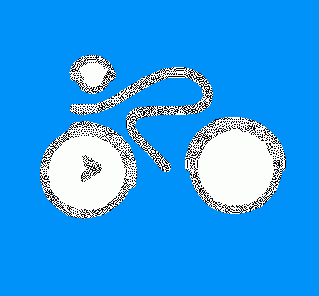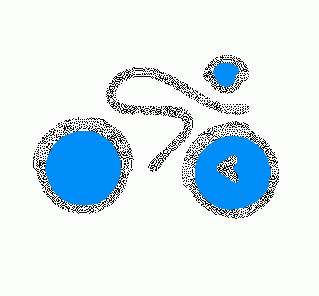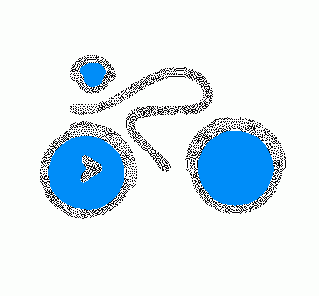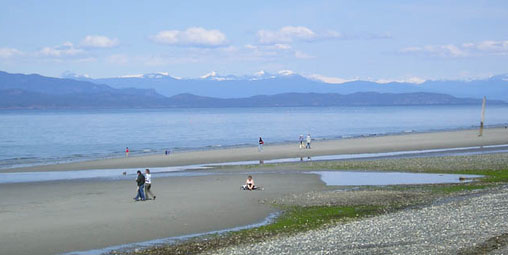| Newsletter - 2006 Archive |

|

|
Cycling Club |

|

|
| Newsletter - 2006 Archive |

|

|
Cycling Club |

|

|
Next--->
|
Sleep-riding
through the Salish Sea: Maybe he stopped for a leisurely, sit-down breakfast. No, I don't think "leisurely" figures in his approach. Lost the route? On a straight, out-and-back course he's ridden before? Not likely. Perhaps he had multiple punctures. These were some of the rationalizations
that ran through my sleepy head, as I tried to figure out how
Lindsay Martin and I had arrived at the first (110km) control
of the 2006 It turned out Ken (perhaps seduced by recent sky-high market prices) had picked up some scrap metal along the route, which had bent his big chain ring - the only one he uses. No problem. The human dynamo had stopped at a gas station, hammered it flat, and continued merrily on his way. As I gulped a muffin and coffee at the Nanaimo 7-11, he leaped back in the saddle and headed north. As we were approaching the turn-around point, Ken passed us heading south, under a full head of steam. Lindsay and I soldiered on, into the stiff northwest breeze alongside the blue waters of Baynes Sound. As onetime mountaineers, we admired the blindingly white, sharks-tooth summits across the Strait, guarding the remote head of Jervis Inlet. Who knew Hell could be so scenic? The headwinds first arose at 8AM (a civilized hour) and continued building toward noon. When we turned south, we would be propelled at record speed, back toward Nanaimo, setting new personal bests. But just shortly after making the Union Bay U-turn, Lindsay announced: "That tail wind has turned into a head wind!" "Uh, yeah, I noticed!" Lindsay and I entertained several theories to account for this phenomenon: the notorious Qualicum winds; some other form of catabatic anomaly, sweeping down from them thar hills; Steve Lonergan had squirted peanut butter into our hubs, while we were lapping cream of broccoli soup at Critters Café; or, the hypothesis I was leaning toward, hallucinatory delirium disorder. After all, we'd been on the road since 3AM, a starting time that had elicited cries of horror from saner folk. Which I guess left us hardcore sleep deprivation researchers to pursue the serious science at hand. Who knows what future advances will issue from our selfless dedication? And it is science that best explains the dashing of our dreams of the perfect tailwind. No, I speak not of the psychology of ego deflation (though its fortunes may also appear subject to vagaries of barometric pressure and ephemeral winds) but the sometimes equally arcane prognostications of meteorology. The aptly-titled Environment Canada paper The Wind Came All Ways* explains that, during the dominant summer pressure-slope pattern, "winds oscillate back and forth in the Georgia Basin … almost like a bathtub." We were taking a bath. "When the pressure slope is near 170° the westerly winds turn and move up the Strait of Georgia …. Typically, they do not go all the way up the Strait, but converge with light northwest winds that occur over the northern part of the Strait, somewhere near Qualicum Beach …. " "The most well-known southwest wind is called the "Qualicum" for it pours out through Port Alberni inlet and over the community of Qualicum, then into the Strait of Georgia." Escaping the fickle zephyrs of Qualicum,
we passed through Parksville, where I noticed Steve's bike, outside
a Starbuck's coffee shop. It was as gratifying to see he was
continuing our sleep deficit research, as much as it was to overcome
his nefarious, gooey hub sabotage plot. He pulled in just behind
us at the third control, The friendly staff at White Spot actually allowed us to bring our bikes into the restaurant and park them behind an unoccupied counter. We experimented with two kinds of pasta - which did nothing for the rambunctious stomach I'd been suffering all day - chased with pure (I read the report) Nanaimo water. We observed that caloric infusion to last about 40 minutes - the amount of time our average speed increased marginally. During that period, we were surprised by my parents (who had been visiting family in Nanaimo) cheering from the shoulder, near Cassidy. That stimulated us as well, but not enough to catch the caffeine-crazed Lonergan, Nigel Press and Luke Galley, who had all now passed us. By the way, would the Vancouver duo please submit your report on the effect of time-release nitro-glycerine. But the best test was yet to come, at 370 kilometres: the somnambulant slog up Shawnigan Lake Road, back to the frigid, moonlit summit of the Malahat. When I looked up from the kaleidoscope of grit, pebbles and small, pressed amphibians slowly passing under the fading white orb of my headlight, steely stars alerted me to the correct orientation of the universe, above the black gauntlet of trees. Lindsay said at the end, that the dreaded sting in the tail of this ride "wasn't too bad." I wondered if I were still adrift, dreaming on the Salish Sea. Had I walked, not into a neon-lit Tim Horton's, but through Alice's looking glass? I was knackered! Why did I find this ride so hard (besides the circadian rhythm study obligations and the aforementioned intestinal ailment)? I looked at results from previous years and compared my more favourable experience at last year's "very difficult" Baker 400. I sent webmaster Eric Fergusson the elevation-gain data from my altimeter - 2940 metres - and wondered why Stephen Hinde had come up with 510 metres less climbing, last year. Then it dawned on me: In 2005, the Vancouver Island 400 route had used the Duncan-Campbell River variation - sans Malahat! Well, I'm off for an afternoon nap; perchance to dream of that ultimate tailwind. *Referenced in "Wind Patterns in the Georgia Basin - the Salish Sea" - Owen Lange, Environment Canada.  Riders endured severe conditions on the H2H route. May 17, 2006 |
_